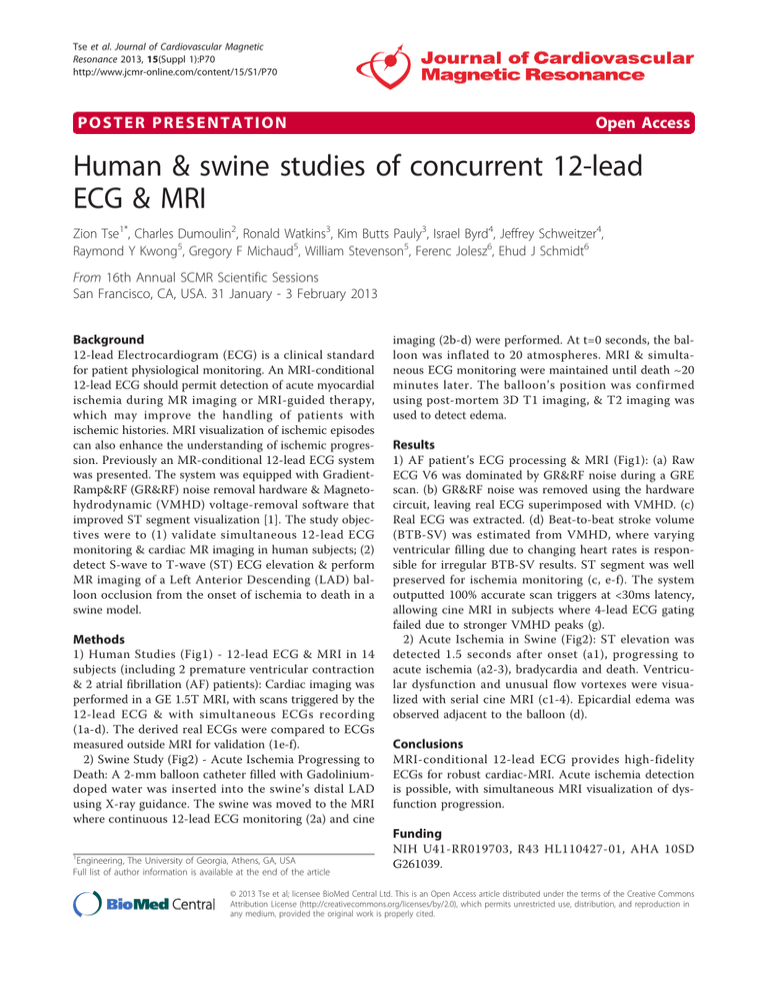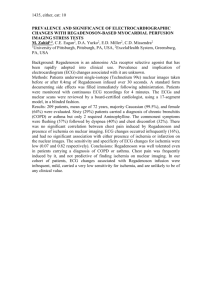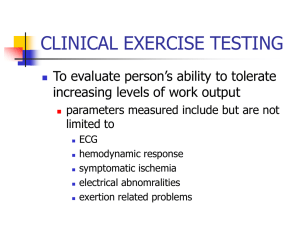Human & swine studies of concurrent 12-lead ECG & MRI Open Access
advertisement

Tse et al. Journal of Cardiovascular Magnetic Resonance 2013, 15(Suppl 1):P70 http://www.jcmr-online.com/content/15/S1/P70 POSTER PRESENTATION Open Access Human & swine studies of concurrent 12-lead ECG & MRI Zion Tse1*, Charles Dumoulin2, Ronald Watkins3, Kim Butts Pauly3, Israel Byrd4, Jeffrey Schweitzer4, Raymond Y Kwong5, Gregory F Michaud5, William Stevenson5, Ferenc Jolesz6, Ehud J Schmidt6 From 16th Annual SCMR Scientific Sessions San Francisco, CA, USA. 31 January - 3 February 2013 Background 12-lead Electrocardiogram (ECG) is a clinical standard for patient physiological monitoring. An MRI-conditional 12-lead ECG should permit detection of acute myocardial ischemia during MR imaging or MRI-guided therapy, which may improve the handling of patients with ischemic histories. MRI visualization of ischemic episodes can also enhance the understanding of ischemic progression. Previously an MR-conditional 12-lead ECG system was presented. The system was equipped with GradientRamp&RF (GR&RF) noise removal hardware & Magnetohydrodynamic (VMHD) voltage-removal software that improved ST segment visualization [1]. The study objectives were to (1) validate simultaneous 12-lead ECG monitoring & cardiac MR imaging in human subjects; (2) detect S-wave to T-wave (ST) ECG elevation & perform MR imaging of a Left Anterior Descending (LAD) balloon occlusion from the onset of ischemia to death in a swine model. Methods 1) Human Studies (Fig1) - 12-lead ECG & MRI in 14 subjects (including 2 premature ventricular contraction & 2 atrial fibrillation (AF) patients): Cardiac imaging was performed in a GE 1.5T MRI, with scans triggered by the 12-lead ECG & with simultaneous ECGs recording (1a-d). The derived real ECGs were compared to ECGs measured outside MRI for validation (1e-f). 2) Swine Study (Fig2) - Acute Ischemia Progressing to Death: A 2-mm balloon catheter filled with Gadoliniumdoped water was inserted into the swine’s distal LAD using X-ray guidance. The swine was moved to the MRI where continuous 12-lead ECG monitoring (2a) and cine 1 Engineering, The University of Georgia, Athens, GA, USA Full list of author information is available at the end of the article imaging (2b-d) were performed. At t=0 seconds, the balloon was inflated to 20 atmospheres. MRI & simultaneous ECG monitoring were maintained until death ~20 minutes later. The balloon’s position was confirmed using post-mortem 3D T1 imaging, & T2 imaging was used to detect edema. Results 1) AF patient’s ECG processing & MRI (Fig1): (a) Raw ECG V6 was dominated by GR&RF noise during a GRE scan. (b) GR&RF noise was removed using the hardware circuit, leaving real ECG superimposed with VMHD. (c) Real ECG was extracted. (d) Beat-to-beat stroke volume (BTB-SV) was estimated from VMHD, where varying ventricular filling due to changing heart rates is responsible for irregular BTB-SV results. ST segment was well preserved for ischemia monitoring (c, e-f). The system outputted 100% accurate scan triggers at <30ms latency, allowing cine MRI in subjects where 4-lead ECG gating failed due to stronger VMHD peaks (g). 2) Acute Ischemia in Swine (Fig2): ST elevation was detected 1.5 seconds after onset (a1), progressing to acute ischemia (a2-3), bradycardia and death. Ventricular dysfunction and unusual flow vortexes were visualized with serial cine MRI (c1-4). Epicardial edema was observed adjacent to the balloon (d). Conclusions MRI-conditional 12-lead ECG provides high-fidelity ECGs for robust cardiac-MRI. Acute ischemia detection is possible, with simultaneous MRI visualization of dysfunction progression. Funding NIH U41-RR019703, R43 HL110427-01, AHA 10SD G261039. © 2013 Tse et al; licensee BioMed Central Ltd. This is an Open Access article distributed under the terms of the Creative Commons Attribution License (http://creativecommons.org/licenses/by/2.0), which permits unrestricted use, distribution, and reproduction in any medium, provided the original work is properly cited. Tse et al. Journal of Cardiovascular Magnetic Resonance 2013, 15(Suppl 1):P70 http://www.jcmr-online.com/content/15/S1/P70 Page 2 of 4 Figure 1 ECG processing of an AF patient in a 1.5T MR. In (b) MR imaging noise is removed. In (c) VMHD is removed & (d) Stroke volume is provided. (e) The ST elevation mean increased by only 2.5%-5% (0.062-0.13mV) between ECGs taken (i) outside MRI and (iii) inside MRI with ECG filtered. (f) The corresponding standard deviations are close (1.4-1.6), showing that the filtered ECG taken in (iii) is very close to the true ECG in (i). VMHD in (iii) was effectively removed, extracting real ECG. (g) 12-lead ECG-gated cardiac cine in a subject whose 4-lead ECG gating failed due to a strong MHD peak voltage which eclipsed the QRS complex. Tse et al. Journal of Cardiovascular Magnetic Resonance 2013, 15(Suppl 1):P70 http://www.jcmr-online.com/content/15/S1/P70 Page 3 of 4 Figure 2 (a) Evolution of ST elevation over time, occasional PVCs and development of bradychardia are clear. (b) Inflated balloon position. (c1-4) Irregular flow patterns during ischemia at Δt=120-140sec. (d) Epicardial edema proximal to occlusion point. Tse et al. Journal of Cardiovascular Magnetic Resonance 2013, 15(Suppl 1):P70 http://www.jcmr-online.com/content/15/S1/P70 Page 4 of 4 Author details 1 Engineering, The University of Georgia, Athens, GA, USA. 2Radiology, Cincinnati Children’s Hospital Medical Center, Cincinnati, OH, USA. 3 Radiology, Stanford University, Stanford, CA, USA. 4Cardiovascular and Ablation Technologies, St Jude Medical Inc, St. Paul, MN, USA. 5Cardiology, Brigham and Women’s Hospital, Boston, MA, USA. 6Radiology, Brigham and Women’s Hospital, Boston, MA, USA. Published: 30 January 2013 Reference 1. Tse ZTH:. ISMRM , ‘09-’11. doi:10.1186/1532-429X-15-S1-P70 Cite this article as: Tse et al.: Human & swine studies of concurrent 12lead ECG & MRI. Journal of Cardiovascular Magnetic Resonance 2013 15 (Suppl 1):P70. Submit your next manuscript to BioMed Central and take full advantage of: • Convenient online submission • Thorough peer review • No space constraints or color figure charges • Immediate publication on acceptance • Inclusion in PubMed, CAS, Scopus and Google Scholar • Research which is freely available for redistribution Submit your manuscript at www.biomedcentral.com/submit






